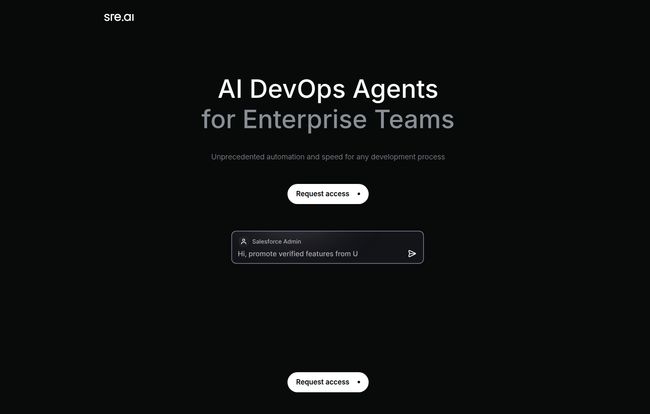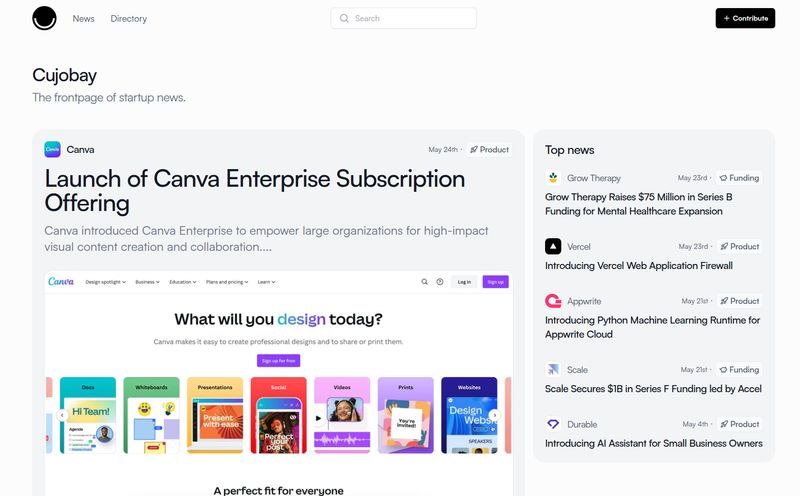If you’ve worked in the Salesforce ecosystem for more than a few months, you’ve felt the pain. That special kind of stomach-churning dread that hits on a Friday afternoon when a critical deployment is scheduled. You’ve prayed to the metadata gods, you’ve triple-checked your change sets, and you’ve still spent a weekend untangling a mess of dependencies in a sandbox that decided to just… stop working.
We’ve all been there. It’s a rite of passage. For years, we’ve been given tools that promise to make it better. CI/CD platforms, version control systems, you name it. And they've helped, for sure. But they often feel like putting a faster engine in a car with square wheels. The core problem—the sheer complexity of Salesforce deployments—remains.
So when I first saw SRE.ai, I had my usual reaction: a healthy dose of professional skepticism mixed with a tiny, flickering flame of hope. Billed as an “AI-powered automation platform” with “AI DevOps Agents,” it’s making some mighty big promises. But then I saw the names backing it—Google, DeepMind, Combinator. Okay, that got my attention. These aren’t folks who typically back vaporware.
So What Is SRE.ai, Really?
At its heart, SRE.ai isn't just another deployment checklist tool. The whole idea revolves around giving your team AI-powered agents. Think of it less like a rigid assembly line and more like hiring a super-smart, impossibly fast junior DevOps engineer who exclusively handles the tedious, error-prone parts of the release cycle.
Instead of you manually mapping out every step of a complex deployment, the platform uses AI to understand the context, anticipate problems, and automate the entire process. It’s designed to work through natural language, which is a fascinating concept. The dream is to move away from writing complex configuration files and closer to just telling your AI agent, “Hey, promote the Q2 sales update from UAT to Production next Tuesday at 2 AM.” A guy can dream, right?
This isn’t just about making things faster; it’s about making them smarter. The name itself, SRE, is a nod to Site Reliability Engineering, the discipline Google created to manage its own massive systems. That tells you a lot about the philosophy here: it's about reliability and proactive problem-solving, not just pushing code.
The Features That Actually Matter
A feature list is just a feature list until you see how it solves a real problem. Let’s break down what SRE.ai brings to the table and why it might actually move the needle for exhausted Salesforce teams.
Deployments on Autopilot?
The headline feature is, of course, the fast deployments and back-promotions. SRE.ai claims you can deploy with a click, a chat message, or an API call. This is where the AI agent concept shines. It’s not just triggering a script; it’s supposed to be intelligently handling the promotion, which includes the often-forgotten and painful task of back-promoting changes to keep your sandboxes in sync. No more sandbox drift? That alone would be worth its wieght in gold.
Your Proactive Error Detective
Here’s what really piqued my interest. The platform promises to “Resolve errors at any layer, and prevent them proactively.” Anyone who has stared at a cryptic “UNKNOWN_EXCEPTION” error in Salesforce knows this is the holy grail. The AI is designed to catch dependency issues, metadata conflicts, and integration errors before they blow up your org. It analyzes the changes, simulates the deployment, and flags potential disasters. It’s like having a crystal ball that’s actually useful, instead of one that just shows you a vague image of yourself crying at your desk.

Visit SRE.ai
Gaining Crystal Ball Insights for Releases
This ties directly into the previous point. SRE.ai provides release insights with simulations and impact reports. Before you even think about deploying, you can run a full simulation to see what will happen. It can generate change analyses and even run performance tests. This shifts the entire dynamic of a release from a high-stakes gamble to a calculated, informed process. You're not just hoping for the best; you're verifying it.
Who Is This Really For?
Let’s be clear. If you’re a solo admin managing a relatively simple Salesforce org, this is probably overkill. This tool is aimed squarely at enterprise teams. The kind of teams juggling multiple developers, a dozen sandboxes, complex Apex classes, and a release calendar that looks like a Jackson Pollock painting. It's for organizations where a failed deployment doesn’t just mean a minor inconvenience—it means lost revenue and a full-blown crisis meeting.
It’s for the teams who have already invested in DevOps but are finding their current tools are still too manual, too brittle, and require a dedicated specialist to keep the engines running.
The Good, The Not-So-Bad, and The AI
No tool is perfect, especially one this ambitious. Based on what they're sharing, here's my breakdown.
The upside is pretty clear: a huge potential for improved productivity and, more importantly, a reduction in release-day anxiety. I can’t overstate the value of giving developers their weekends back. Faster, safer releases mean a more agile business, and the seamless integration with existing tools like Git means you don’t have to burn your current process to the ground.
On the other hand, there are considerations. Right now, it’s laser-focused on Salesforce. That’s great for depth, but if you’re running a multi-cloud environment, you’ll need other solutions for other platforms. The biggest hurdle, though, is philosophical. You have to trust the AI. Handing over the keys to your production org to an AI agent requires a leap of faith. The platform does talk about human-in-the-loop configuration, which is reassuring. It’s not a black box; it's a co-pilot that you can guide and override. Which is probably for teh best.
What’s the Damage? A Look at SRE.ai Pricing
This is the million-dollar question, isn't it? As of this writing, if you try to find the pricing page for SRE.ai, you’ll be greeted with a friendly 404 “Page not found” error. While that might be a small hiccup, it tells me a few things.
First, they're likely in a controlled rollout or early access phase. The “Request access” button on the homepage confirms this. They're probably hand-picking their first customers to ensure success and gather feedback. Second, the pricing is almost certainly not going to be a simple, off-the-shelf number. For an enterprise-grade tool like this, expect a custom quote based on the number of users, the complexity of your org, and the level of support you need. It won’t be cheap, but if it solves a multi-million dollar problem, the ROI could be massive.
Frequently Asked Questions about SRE.ai
How do we get started with SRE.ai?
Currently, access is by request only. You'll need to head to their website and hit the “Request access” button. They are likely onboarding teams that are a good fit for the platform's current capabilities.
Can we really trust an AI agent with our deployments?
This is the core concern for many. The trust is built on a few pillars: the credibility of the team and backers (Google, DeepMind), the promise of simulations and proactive error checking, and the human-in-the-loop controls that ensure you have the final say. It's designed to be a trusted co-pilot, not a rogue self-driving car.
What platforms does SRE.ai support?
The primary focus is the Salesforce ecosystem. However, its architecture is built around deep integrations with the tools you already use, like version control systems (e.g., GitHub, Bitbucket) and project management software.
What’s the inspiration behind the name?
SRE stands for Site Reliability Engineering, a set of principles and practices pioneered at Google for building and maintaining large-scale, ultra-reliable systems. Choosing this name signals a deep commitment to stability and proactive, automated operations, not just speed.
Is this just another CI/CD tool like Gearset or Copado?
While it operates in the same space, SRE.ai positions itself differently. Traditional CI/CD tools are more like workflow automation. SRE.ai's angle is the intelligent, AI-powered agent that understands context and makes decisions, aiming for a higher level of automation and error prevention. It's an evolution of the concept.
Is this tool going to replace my DevOps engineer?
Highly unlikely. It’s a force multiplier. It automates the repetitive, soul-crushing tasks, freeing up your valuable DevOps experts to focus on higher-level architecture, strategy, and solving novel problems. It makes them more powerful, it doesn't make them obsolete.
Final Thoughts: A Cautiously Optimistic Verdict
Look, the Salesforce world is littered with tools that promised a revolution and delivered a minor tweak. SRE.ai is making some of the boldest claims I've seen in a while. But unlike many others, it seems to have the technical pedigree and the philosophical approach to potentially back it up.
The focus on AI agents, proactive error prevention, and true reliability engineering is the right direction. If they can deliver on even 80% of their promises, SRE.ai could fundamentally change how enterprise teams handle their Salesforce development lifecycle. I’m not ready to call it a revolution just yet, but I’m definitely grabbing a front-row seat with a big bag of popcorn. This is a platform to watch.
Reference and Sources
- The official SRE.ai website: sre.ai
- Salesforce Developer Blog on Sandbox Management: Get Started with Salesforce DX
- Google's Introduction to Site Reliability Engineering: SRE Book: Introduction



